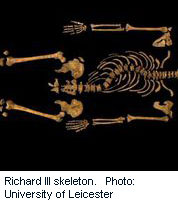- How Daily Prunes Can Influence Cholesterol and Inflammation
- When to Take B12 for Better Absorption and Energy
- Epsom Salts: Health Benefits and Uses
- See What Saffron Can Do for Sleep and Heart Health
- 6 Common Mistakes to Avoid Before Your Physical
- Can Sweating Really Help You Beat a Cold?
- Strengthening Your Relationship: Practical Strategies
- Skip Storing This Everyday Product in the Fridge Door
- Green Tea + B3 Pairing May Boost Brain Health
- Navigating Your Midlife Crisis: Embracing New Possibilities
Richard III’s Curved Spine Had Little Impact on His Mobility: Study


The bones of England’s King Richard III are yielding up more secrets about the 15th century monarch, two years after his remains were excavated under a parking lot in Leicester, Great Britain.
The new research, published May 29 in The Lancet, suggests the spinal scoliosis noted initially in Richard’s skeleton may not have unduly hampered his movement or appearance.
“There is no evidence to suggest Richard would have walked with an overt limp, as his curve was well balanced and the bones of the lower limbs symmetric and well formed,” study co-author Dr. Jo Appleby, lecturer in human bioarchaeology at the University of Leicester, said in a journal news release.
Richard III, immortalized in a play of the same name by Shakespeare, ruled England from 1483 until he was killed in battle in 1485.
In numerous historical and literary sources, Richard III is referred to as “crook-backed” or “hunch-back’d,” but it’s never been clear whether such descriptions are accurate or were used to portray him in a negative way.
His skeleton was discovered in Leicester in 2012 and initial examinations revealed that he did have scoliosis, in which the spine curves to the side.
However, the new research suggests that the spinal condition had little effect on his physical appearance and would not have affected his ability to exercise.
In this study, researchers used data from CT scans to create 3-D images and actual models of the king’s spine. This enabled them to get a better understanding of Richard III’s spinal condition and how it affected his appearance.
The investigators concluded that the king’s scoliosis was unlikely to have been genetic and likely appeared sometime after age 10. The condition is called adolescent-onset idiopathic scoliosis, and is one of the most common types of scoliosis, the study authors noted.
“The physical deformity produced by Richard’s scoliosis was probably slight as he had a well-balanced curve of the spine,” study author Piers Mitchell, of the department of archaeology and anthropology at the University of Cambridge in England, said in the news release.
“His trunk would have been short relative to the length of his limbs, and his right shoulder a little higher than the left. However, a good tailor to adjust his clothing and custom-made armor could have minimized the visual impact of this,” Mitchell added.
And, Appleby said, “The moderate extent of Richard’s scoliosis is unlikely to have resulted in any impaired tolerance to exercise from reduced lung capacity.”
More information
The U.S. National Institute of Arthritis and Musculoskeletal and Skin Diseases has more about scoliosis.
Source: HealthDay
Copyright © 2026 HealthDay. All rights reserved.










